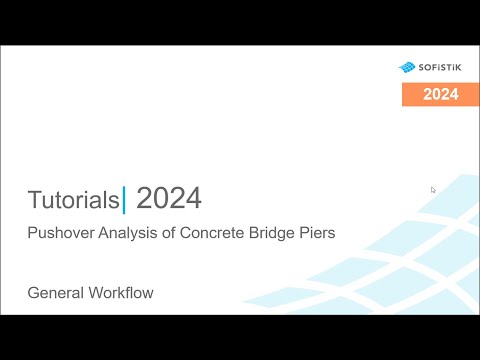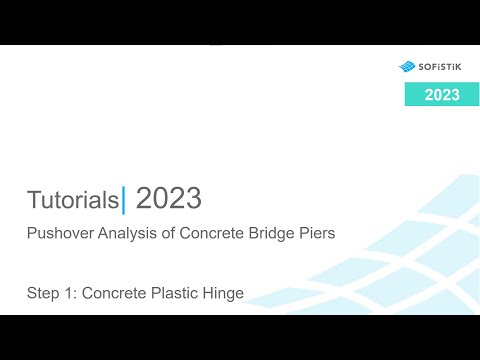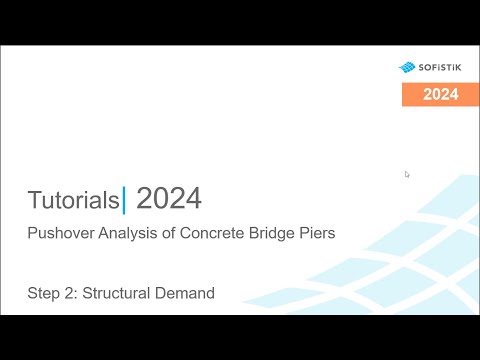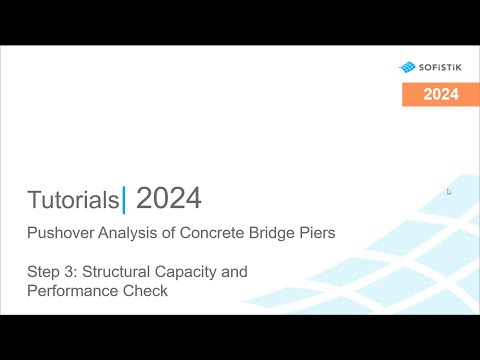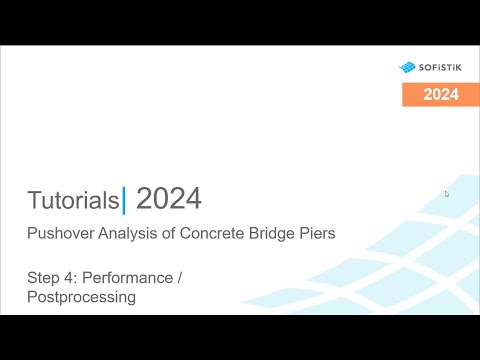Pushover Analysis - Bridge Piers#
Introduction#
Welcome to the Pushover Analysis - Bridge Piers tutorial.
In this tutorial we are assesing the seismic behaviour of a two-column concrete bridge pier modelled in SOFiPLUS, and analysed in the SOFiSTiK Structural Desktop. We perform a pushover analyis by incrementally increasing a predefined load pattern to meet a specified structural demand. The nonlinear structural behaviour is modelled using concentrated plasticity models, i.e., concrete plastic hinges.
We divide the Pushover Workflow into 4 distinct steps:
Modelling of Concrete Plastic Hinge
Determination of Structural Demand
Calculation of Structural Capacity with Performance Check
Assessing Structural Performance with Postprocessing tools
By the end of the tutorial, you should be able to:
Define Concrete Plastic Hinges based on a cross-sectional analysis and assigning them to a model in SOFiPLUS.
Conduct a seismic Response Spectrum Analysis (RSA) for this model to determine the Structural Demand.
Setup and perform a nonlinear Pushover Analysis to determine the inelastic structural behaviour.
Perform checks of the structural performance by looking at the performance levels of plastic hinges and internal forces of structural elements.
Project Description#
The example a two-column reinforced concrete pier with a header beam. The structure is 13 m high with 8 m space between the columns. The cross-section of the column is circular with radius of 1.6 m, reinforced by approximately 150 cm2 steel. The header is rectangular beam with dimensions of 1.6 m x 1.8 m. We use the standard concrete C 35/45 and standard reinforcement B 500 as materials. In addition to the self-weight of the pier bridge structure, there is a dead load of 3000 kN applied at three locations of the pier to simulate the permanent loading transferred by the main girders of the superstructure.
![Pushover Analysis - Bridge Piers: Structure and additional dead load [kN]](../../_images/DescriptionExample.png)
Pushover Analysis - Bridge Piers: Structure and additional dead load [kN] (click on image to enlarge)#
Plastic Hinges#
A plastic hinge is a family of idealised plastic Moment-Rotation worklaws, possibly at various normal force levels. These worklaws are obtained based on a cross-sectional analysis and subsequent idealisation method. We use the Concrete Plastic Hinge Task to determine the plastic hinges for the present example.
Note
Polygonal cross sections (e.g., rectangular) it must be defined through SOFiPLUS or SECT in AQUA with the reinforcement specified as “minimum reinforcement”. Otherwise, the reinforcement will not be taken into account in the cross sectional analysis.
Tip
When dealing with a confined concrete cross-section, the Concrete Plastic Hinge Task offers a new option called ‘Core Material (Confined)’ for specifying the reference material of the confined section. This selection enables the concrete strain limits to be assessed only for the chosen section, and in this way allowing the concrete cover to fully crack.
Note
The following video is taken from the Pushover Analysis - Bridge Piers Tutorial - version 2023. The same principles remain applicable to the SOFiSTiK version 2024. New features like the idealisation acc. CALTRANS, Core Material, Plastic Moment Amplification and Hardening Factor are described in detail in the FEABENCH manual and the Concrete Plastic Hinge Task help section.
Demand#
We perform Response Spectrum Analysis by using the Earthquake RSA Task. The analysis is based on a given site seismicity to determine the structural demand in terms of target displacement. The structure is modelled to take into account the cracking of the concrete by reducing the stiffness of the columns. The stiffness reduction factor is based on the cross sectional analysis of the plastic hinge at the normal force levels due to (quasi-)permanent loading.
Capacity and Performance Check#
We determine the structural capacity and proceed with the Performance Check by using the Pushover Analysis - Bridge Piers Task. The structural capacity is analysed by increasing a particular seismic load pattern Here, the seismic load pattern is based on the most relevant mode-shape for the activation of 90% of the mass in X direction. The structure is modelled with reduced elastic stiffness (based on cross sectional analysis). Starting from the system state under permanent loads (initial loading state), the structure is pushed by incrementally increasing the seismic loads in the scope of a nonlinear static analysis until the target displacements at the selected node is reached.
Subsequent performance evaluation can be done by selecting the Base shear - Control node displacement check which will generate a plot of the structure’s base shear force vs. the displacements in the specified point of interest. Additionally, the Spectral acceleration - Spectral displacement check can also be requested.
Note
Additional information about the Spectral Acceleration - Spectral Displacement check method can be found in the SOFiLOAD manual.
Performance / Postprocessing#
Once we determine the structural behaviour at the target demand displacement, we can evaluate the structural performance by looking at the performance levels of the hinges, internal forces and displacements. To do this, we use our standard postprocessing tools such as Graphic and Result Viewer.
Tip
You may parametarise the plots created with Graphic by using the CADINP language in the TEXT Editor for all incremental steps in the report.
